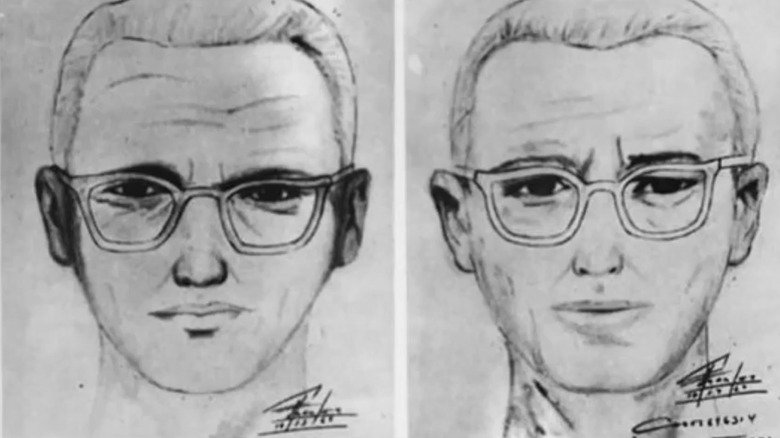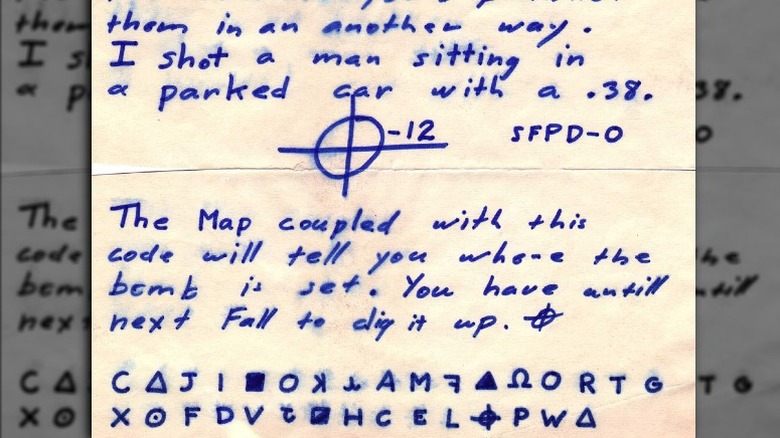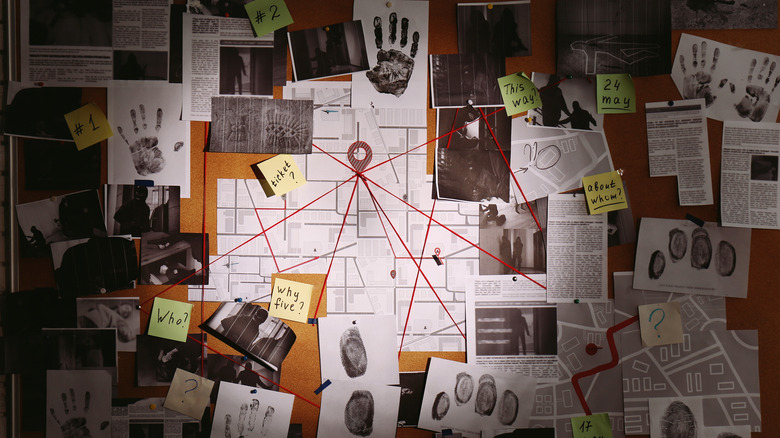The Untold Truth Of The Zodiac Killer
We may receive a commission on purchases made from links.
Editor's note: On October 6, 2021, an investigative team announced they have identified the Zodiac Killer as Gary Francis Poste, who died in 2018 (via Fox News).
The Zodiac Killer, or simply "Zodiac," as he called himself, was one of America's most notorious criminals, responsible for a series of murders between 1968 and 1969 in California's Bay Area in Northern California. Today, the killer is best known for sending taunting letters to the police discussing details of the killings, and containing ciphers describing his motivations and even his identity. He insisted that his ciphers be printed on the front page of locals newspapers for anyone to decode. One set of lines, translated by high school teacher Donald Harden and his wife, Bettye, as described by Biography, infamously states, "I like killing people because it is so much fun," and, "It is more fun than killing wild game in the forest because man is the most dangerous animal of all." The Zodiac Killer left an emblem on each of his letters: a circle with a cross in the middle.
To this day, over 50 years later, the case remains open, and investigators stumped. Many films, shows, and documentaries have speculated about the potential perpetrator, most notably 2007's David Fincher film "Zodiac," featuring Robert Downey, Jr. and Mark Ruffalo as detectives aided by cartoonist Robert Graysmith (Jake Gyllenhaal). The sketch of the serial killer as a narrow-chinned, short-haired, bespectacled white man, has become as instantly recognizable as his circle-and-cross emblem.
Ultimately, the Zodiac Killer vanished as abruptly as he started, leaving five official killings attributable to him, although he claimed to have murdered 37 total, per CNN.
Zodiac targeted couples on Bay Area dates
"Dear Editor," all three letters began, "I am the killer of the 2 teenagers last Christmas at Lake Herman." Each letter, received at the desks of the San Francisco Examiner, San Francisco Chronicle, and Vallejo Times-Herald on August 1, 1969, described details of the crimes that only the police knew. And, each letter contained one-third of a cipher that, when assembled, constructed the now well-known, disturbing "man is the most dangerous animal of all" quote, as Biography tells us. A bit frenetic, full of spelling and grammatical errors, bold and brazen, the letters illustrated that the Zodiac Killer wasn't at all a typical case.
The first victims of the Zodiac Killer were shot while parked in a car on a date — David Faraday in the head, Betty Lou Jensen in the back while trying to escape — in the city of Benicia north of the Golden Gate Bridge, as the Hindustan Times explains. The next victims, Michael Mageau and Darlene Ferrin, were shot in almost the exact same fashion on July 4th, while parked in a car in Blue Rock Springs Park, about 4 miles from the previous victims. Mageau survived the attack. The last targeted couple were Bryan Hartnell and Cecelia Shepard. They sat on the shore of a remote area of Lake Berryessa a bit north of Napa, on September 27. Zodiac attacked both with a knife. Hartnell survived the attack but Shepard died two days later from her wounds.
The infamous Presidio Heights sketch
In between his attacks, the Zodiac Killer sent his taunting letters full of ciphers discussing his motives and, he stated, his identity. Beyond these, the most long-lasting piece of evidence we have to identify him is the now-infamous "Presidio Heights" sketch.
A mere two weeks after his final attack at Lake Berryessa, on October 11, 1969, a man got into a taxi in San Francisco's theater district and requested a ride to Washington and Maple Street — stopping a block early. After the taxi stopped, he pulled a gun and shot the driver, Paul Stine, in the head, and made off with his wallet, keys, and a part of his bloody shirt. The crime, ostensibly a robbery, didn't fit Zodiac's modus operandi, and the police didn't suspect him until they received mail from him not only claiming the crime, but containing a strip of Paul Stine's shirt. In fact, the Zodiac Killer said he actually chatted with police shortly after the murder took place.
As it turns out, three teenagers saw the whole thing from the sidewalk. Their description of the murderer produced the now-famous glasses-wearing portrait (on the left, above). And as Zodiac Ciphers explains, Donald Fouke, a police officer who talked to the man later believed to be Zodiac, produced an almost identical sketch (on the right, above). The only problem? His description might have been biased because the former picture had already been circulating around the Bay Area.
Prime suspects, long lost parentage, and sketchy evidence
There have been several Zodiac Killer suspects over the years, although no one has been formally charged.
Most distinctively, various circumstantial evidence supported the claim that disgraced school teacher Arthur Leigh Allen was the Zodiac killer. As stated on History, Allen liked to go shooting at the location of the first official victims, Lake Herman. He was a convicted pedophile, per the Guardian, and as Filmy Daily tells us, he even (to complete the stereotype) lived at home with his mother well into middle age. Curiously, he even favored Zodiac brand watches. Allen, however, died of a heart attack in 1992.
More recently, in the 2014 book "The Most Dangerous Animal of All," New Orleans-born Gary Stewart accused his estranged biological father, Earl Van Best, Jr., of being the killer. Stewart set out to track down his father in 2004, and felt particularly stunned when he saw the 1969 Presidio Heights sketch, as it resembled his father's 1962 mug shot. In Stewart's own words on CNN, he said of his book, "I believe for the first time in the history of this case that I have presented more evidence that has ever been presented on any one suspect." Boasts notwithstanding, much of the evidence is circumstantial, and includes things like both the Zodiac Killer and Van Best enjoying Gilbert and Sullivan's opera, "The Mikado," per SFGate.
Amateur super sleuths cracked a cipher in 2020
Discussions of the Zodiac Killer have become something of a hobby for amateur mystery solvers, as this thread on the Zodiac Killer subreddit illustrates. Conspiracies, analyses of half-century-old events, connections to known people in the case (e.g., police officers as suspects), even talk of hairstyles in the late 1960s, and artwork inspired by the killings: all of it and more can be found online.
Sometimes, though, obsessions yield useful results. Such was the case on December 11, 2020, when YouTuber David Oranchak released a video on YouTube describing how he, part of a team of three "codebreakers," solved the Zodiac Killer's 340-character cipher delivered on November 8, 1969, 51 years prior. They cracked it on December 5, submitted it to the FBI, and went on to pay respects to any remaining relatives in the video they uploaded.
Per The New York Times, the cipher says, in full, "I hope you are having lots of fun in trying to catch me that wasn't me on the TV show which brings up a point about me I am not afraid of the gas chamber because it will send me to paradice [sic] all the sooner because I now have enough slaves to work for me where everyone else has nothing when they reach paradice so they are afraid of death I am not afraid because I know that my new life is life will be an easy one in paradice death."
DNA from refrigerated spit could tell the whole story
Even more promising than the 340-character cipher, dubbed "one of the holy grails of cryptography" by Sam Blake, applied mathematician and one of the people who cracked the cipher, is the possibility for identifying the Zodiac Killer through DNA evidence (per The New York Times). Of course, such forensics didn't exist when the Zodiac Killer was active, and only came into play starting in 1986, as Easy DNA tells us. How is it possible that DNA evidence can be used for the Zodiac Killer, then?
Inspiration comes from the Golden State Killer, who committed over 50 rapes, 12 murders, and burglarized over 100 homes across California in the 1970s and '80s, per All Things Interesting. Investigators reconstructed a DNA profile of the Golden State Killer from old evidence in storage, relying heavily on genetic genealogy services, and compared the results to a massive DNA database. On July 29, 2020, former police officer and Vietnam veteran Joseph James DeAngelo, 76 years old, plead guilty to 26 charges related to his murder and rape spree, and will spend the rest of his life in prison.
The identity of the Zodiac Killer might be uncovered in the same way. Forensics DNA expert Dr. Monte Miller described hope for the case in an interview with CBS affiliate KPIX, watchable on YouTube. Spit, he said, on the killer's cipher-filled letters, might be used to track him down, provided the evidence has been refrigerated and remains uncontaminated.





